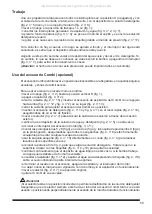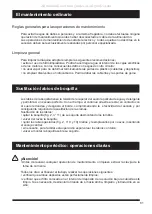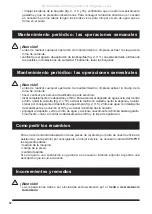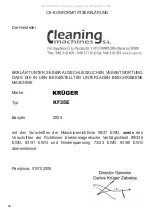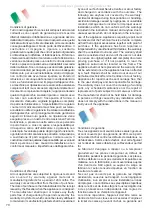
56
Lavado y secado de suelos lisos y ligeramente arrugados.
Abrillantado (con el cepillo especial y los detergentes adecuados).
Alzamiento y transporte de la máquina embalada
La máquina se encuentra embalada en una caja de cartón con asas para facilitar el traslado.
Manejar prestando atención para evitar golpes y no volver del revés.
Controles en la entrega
En el momento de la entrega por parte del transportista, verificar con atención el estado del
embalaje así como la integridad de la máquina. Si resulta que ésta última ha sufrido daños,
hacerlo constar al transportista y aceptar la mercancía indicando por escrito los daños acontecidos
para una posterior reclamación al transporte por los mismos.
Desembalaje
Quitar el embalaje de la máquina realizando las siguientes operaciones:
cortar y eliminar la cinta adhesiva;
abrir la caja de cartón;
agarrar la máquina por el asa (fig.2, n° 2) y alzarla liberándola del cartón;
accionar la palanca para desbloquear el asa (fig. 2, n° 3) y llevarla hacia la posición vertical
de reposo R (según fig. 1 y párrafo "la regulación del mango");
eliminar el cartón y el material de embalaje, usando, si se dispone, contenedores de recogida
selectiva.
¡Atención!
Parar inmediatamente la aspiración cuando interviene la válvula flotante.
Descripción de los mandos
Mandos eléctricos y testigos de señalización colocados en el panel de control (fig. 3)
a. testigo de alimentación (fig. 3, n° 6): de color naranja, señala que el cable de la máquina
está conectado a la red eléctrica;
b. interruptor general (fig. 3, n° 7): activa o desactiva todos las conexiones eléctricas;
c. interruptor luminoso de aspiración (fig. 3, n° 2): enciende y apaga el motor de aspiración;
d. interruptor luminoso de la bomba de solución detergente (fig. 3, n° 3): activa o desactiva la
bomba que envía al cepillo la solución detergente;
e. interruptor luminoso de la bomba de solución detergente para el funcionamiento del accesorio
Posibilidades de empleo
Uso de la máquina
Preparación de la máquina
25
The squeegee blades scrape the film of water and detergent off the floor to make sure the floor
is perfectly dry. With time, continuous scraping erodes and slits the sharp edge which comes
into contact with the floor. When the blades are worn out, the squeegee does not dry the floor
accurately: an indication that the blades require replacement.
To replace the blades, proceed as follows:
to remove the squeegee (fig. 2, no. 11), unscrew from its holder
turn the squeegee upside-down;
pull the worn blades to remove (fig. 2, no. 9 and 10) and replace with new blades by inserting
the tooth into its housing;
if necessary, to make this operation easier, dust the blades with talcum powder;
reassemble the squeegee onto its holder.
The scrubber-drier does not require regular lubrication.
Warning!
Disconnect the plug from the power supply socket before carrying out any maintenance or
cleaning work.
Every day, when you have finished using the appliance carry out the following tasks:
make sure that both tanks are perfectly clean;
make sure that the filter inside the solution tank under the lid is clean. If necessary, pull the
filter upwards to remove. Clean the filter and replace in its housing;
clean the squeegee blades (fig. 2, no. 9 and 10), making sure they have not been subjected
to excessive wear and tear. To make sure that the appliance dries the floor efficiently, the
blades must have a sharp edge to break up the film of water which forms on the floor.
General cleaning
Always adopt the following precautions when cleaning the appliance:
do not use power washers. Water may access the electrical housings or motors and subsequently
damage the appliance or cause a short circuit;
do not use steam, the heat would deform the plastic parts (the casing and tanks);
do not use solvents or hydrocarbons. These could damage the casing or the rubber components.
Replacing the squeegee blades
Lubrication
Scheduled maintenance: daily maintenance tasks
All manuals and user guides at all-guides.com


















